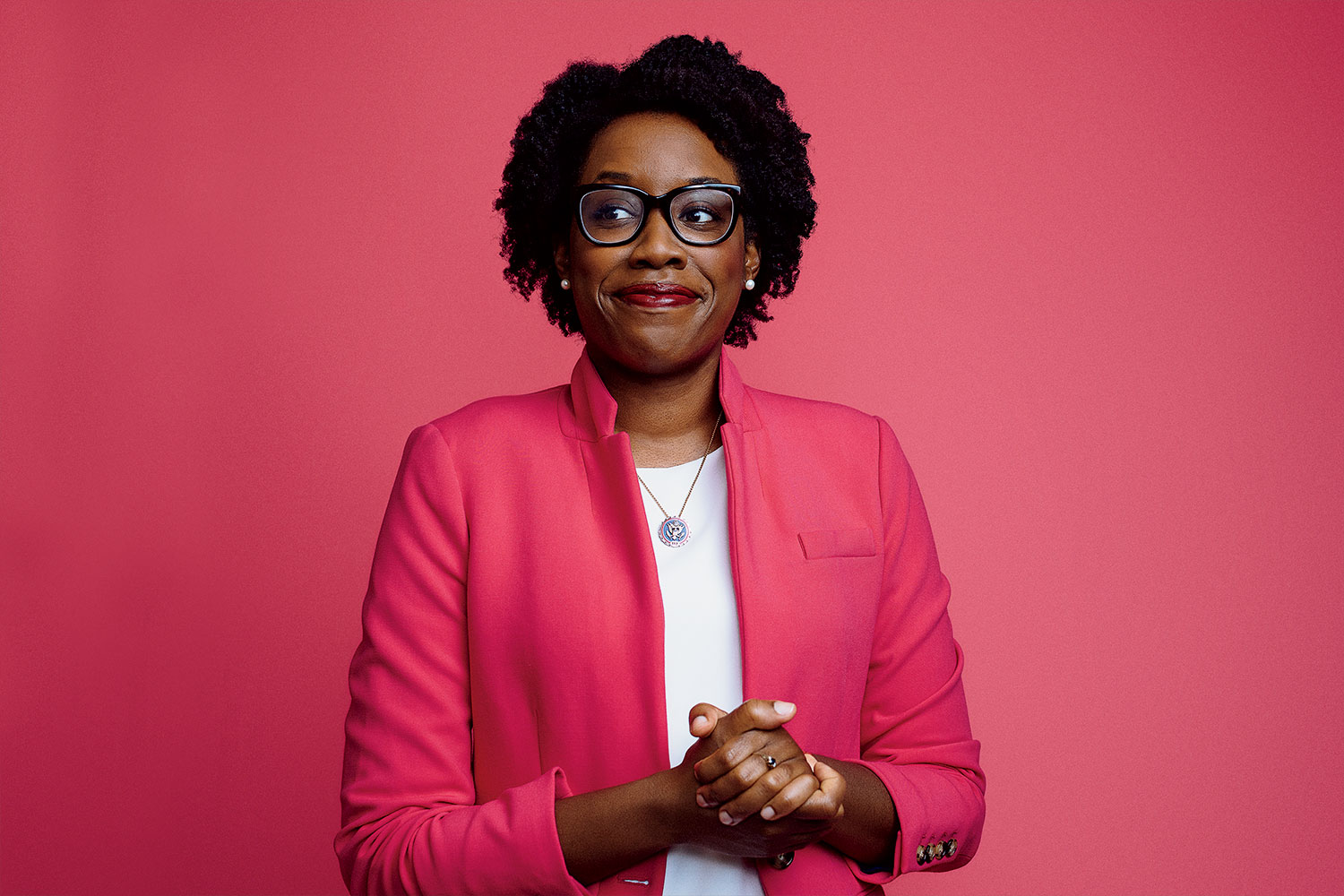Lauren Underwood had just started the master’s program in public health at Johns Hopkins University when she met fellow student Shalon Irving, whose life and death would ultimately help shape the future congresswoman’s career. “It was the first session, the first day, and Shalon was like, ‘Hey, girl.’ She was really bubbly, really kind.”
Underwood was telling me this during an interview by Zoom in February. I was nervous when the call began because my kids had been home from school for nine months and I was worried they might barge into my “office” in the middle of our interview to complain that their laptop wasn’t working or that we were all out of the good cereal. But Underwood’s direct, down-to-earth conversational style put me at ease; she came across as warm and energized, the same way she described her friend. “Shalon and I were, like, good girlfriends. We would pass notes, you know, go to dinner in Baltimore. We were telling each other about who we were dating.”
At the time, Underwood was 21, with a bachelor’s in nursing from the University of Michigan, and the youngest student in the master’s program. (Now, at 34, she is the youngest African American woman ever to serve in the House of Representatives.) After graduation, Underwood and Irving both went on to careers in public health, Irving as an epidemiologist at the Centers for Disease Control and Prevention and Underwood as a senior adviser at the Department of Health and Human Services, where she worked with the Obama administration on implementing the Affordable Care Act.
In 2016, Underwood learned that Irving was expecting a child. “We were all so excited for her. She’d always wanted to be a mom and …” Underwood’s voice caught, hinting at an upwelling of emotion she seemingly hadn’t expected. She began to speak more slowly, as if keeping her reaction in check. “You know how it is with girlfriends, right? You’re in it with your friends.”
Underwood continued, explaining that when she got the good news about her friend’s baby coming, her federal job was wrapping up and she wasn’t sure what she’d do afterward. While she was mulling her next move, bad news followed the good. “Shalon was due in January, and we didn’t hear anything right away,” she said, “but I figured she was overwhelmed. Then I found out that she had died after giving birth.”
Irving had collapsed at home three weeks postdelivery, her death attributed to complications from the high blood pressure she’d been managing for years. As Underwood described going down to Atlanta for the funeral with a friend, she had to pause and take a deep breath. “It was … unimaginable. Her baby was there, her mom was there, the director of the CDC was there, all of these other uniformed public health officials were there, and everybody was stunned. Just like, How could this happen?”
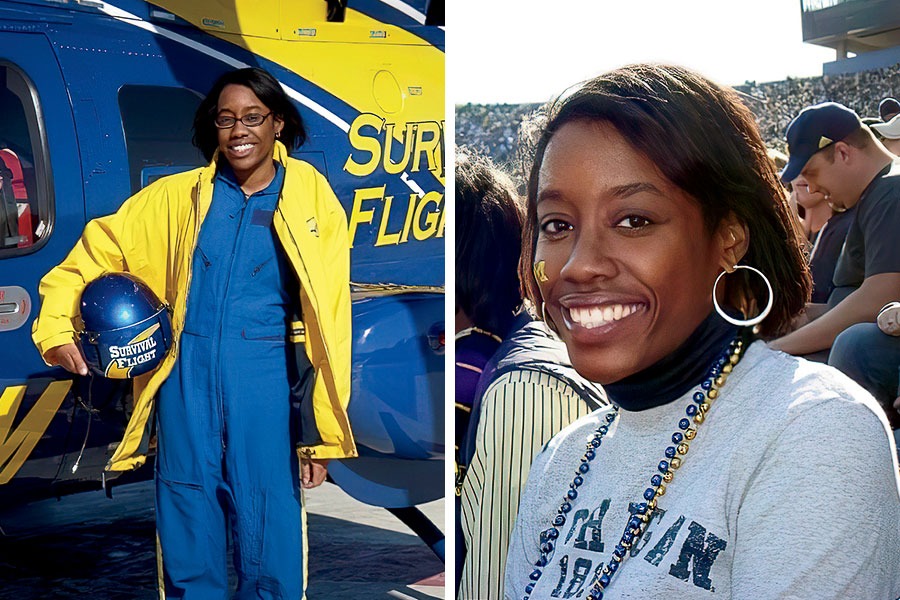
The way Underwood saw it, her friend had done everything right. She was a highly educated woman with excellent insurance who’d received prenatal care from quality providers in the richest country in the world. Her work in the violence prevention division of the CDC had given her intimate knowledge of the extra health risks borne by Black women, who, according to that agency’s data, are up to four times more likely to die from complications related to pregnancy and childbirth than white women. But in the end, none of those advantages had saved her. In late 2017, NPR and ProPublica published a lengthy article that examined Irving’s death through the lens of the health care disparities faced by Black mothers, from biases in pain management and hospital admission to laxity in perinatal care, and pointed to evidence that Irving may have fallen victim to the very inequities she’d dedicated herself to eliminating. (An expert on postpartum care stated in the article that given Irving’s history of hypertension, her doctors should have ordered a full cardiological workup and kept her for monitoring after she developed a hematoma from her C-section.)
In recounting her friend’s death, Underwood, who has been studying racial inequity in health care for years, didn’t draw any explicit conclusions, but she did relate her experience in nursing school: “People would often say things like, ‘Well, there’s something about Black women that makes them more likely to die of these pregnancy-related complications.’ It wasn’t referred to with precision. It wasn’t presented as a deep dive on preeclampsia or some kind of postpartum infection or the role of mental health or specific causes of maternal death. It was just much more broad. … ‘There’s just something about Black women where they’re more likely to die.’ But what I say is, there’s nothing wrong with us genetically. There’s nothing wrong with Black people. This is about racism in our health system.”
By this point, Underwood had abandoned the halting cadence she’d used when recounting the painful memories of her friend’s death and was talking at a brisk clip. She began to enumerate the initiatives she’s championed since being elected to Congress in 2018, specifically the Black Maternal Health Momnibus Act of 2021, which contains provisions addressing inequities in housing, nutrition, and transportation that influence maternal outcomes, as well as plans for eliminating racial bias in the treatment of pregnant women, improving data collection, and bolstering maternal mental health resources.
“There’s nothing wrong with black people,” underwood says. “This is about racism in our health system.”
She noted that the issue of maternal mortality had come up in various ways during Obama’s terms in office, when Underwood was creating policy at the Department of Health and Human Services, but it had never been made a priority. What fledgling programs there were got largely dismantled by the Trump administration. Mothers dying was somehow not an issue that captured the imagination of the political class. This seemed wrong to Underwood. “I think that American people assume that Congress works on the issues that are most important for our country. No, Congress works on the issues that its members raise. And if you do not have a Congress that reflects the lived experiences of the American people, their issues don’t get raised.”
Prompted in part by that observation, I asked the congresswoman at one point if she was planning to have children herself. She opened her mouth to speak but then hesitated, pausing to choose her words carefully. I hadn’t intended it as a loaded question, but I can see now how she might have interpreted it as such.
“Yes,” she said finally, “but I would say that I have not prioritized that. As a woman with agency in her life, I go for what I want, and that has not necessarily been the highest priority.”
“A woman with agency in her life” might strike even a casual observer as an understated description of Underwood. After flipping Illinois’s 14th District — a predominantly white swath of suburbs that favored Donald Trump in 2016 by 4 percentage points — three years ago and then prevailing again in 2020 in a bitterly contested race against a wealthy Trump-aligned conservative, she has emerged as one of the Democratic caucus’s rising stars, and one of the few members of Congress whose education trained them for a solidly middle-class profession like nursing. In 2019, she was named to Time’s “100 Next” list. “Congresswoman Underwood is blazing a trail for a new generation of unbought and unbossed leaders,” wrote Senator Cory Booker in the magazine, “and I know that one day soon, another newly elected Congressperson will look back at her example and be inspired to do the same.”
Underwood seems well suited to thrive in the Biden era. Like the president, she has advanced a liberal agenda without resorting to the kind of incendiary rhetoric and bare-knuckle combat favored by Alexandria Ocasio-Cortez and other members of the so-called Squad. “When I got to Congress, I came in with a class of a lot of big personalities,” Underwood said equably when I asked her about her colleagues. “And being a young woman of color who was there with some stars, I thought it was important for people to get to know me, to understand the district that I represent, and the work that I want to do.”
Part of Underwood’s softer approach is certainly tactical. After all, 49 percent of voters in Underwood’s district — which wraps around the northern and western edges of the Chicago area, stretching as far north as the Wisconsin border and as far south as I-80 — favored her Republican opponent, the dairy magnate Jim Oberweis, in 2020. Her margin wasn’t much bigger in her landmark 2018 victory over Randy Hultgren, a four-term Republican incumbent.
Sometimes Underwood’s play-nice approach can come across as a reluctance to punch back. During a public forum held virtually for the two candidates ahead of the 2020 vote, Oberweis, seated at his desk beside a portrait of Ronald Reagan, attacked Underwood for her “pattern of silence when it comes to the radical ideas of the far left.” At one point, he accused her of having a secret left-wing agenda: “She ran two years ago like a moderate Democrat, but she has governed since then like a radical socialist.” Here Underwood paused, displaying an uncanny ability, one she shares with Joe Biden, to continue smiling even as the arrows fly. “Well,” she said, “my opponent has been using his time to launch character attacks, and I’ve been spending my time as your representative, focused on the issues and focused on serving this community.”
In Underwood’s view, there is a moral cost to delaying immediate remedies in the name of achieving more profound future gains.
I asked veteran Democratic congressman Danny Davis, who has represented parts of downtown Chicago since 1997 and has more than a few liberal bona fides of his own, what he thought of Underwood’s penchant for avoiding the fray. “You can acknowledge and recognize differences that people have, and you can even interact with people who get down in the mud,” he said, “but you don’t have to get down there with them.” He added, “Everyone knows that she represents a congressional district that does not necessarily have a lot of African Americans. It’s conservative. It’s white. … It is so good to see what is going on with her. It helps me to believe that America is becoming the country Dr. Martin Luther King thought we could become.”
Not all the mud is being slung from the right. Underwood has been criticized for, among other things, failing to support Medicare for All, the single-payer national health insurance system advanced most recently by Representatives Pramila Jayapal and Debbie Dingell. Underwood was one of the few House Democrats of the new guard not to cosponsor that bill; instead, she presented a plan that works within the current system, offering an expansion of premium tax credits and ACA coverage to lower-income Americans and to those who have lost work during the pandemic.
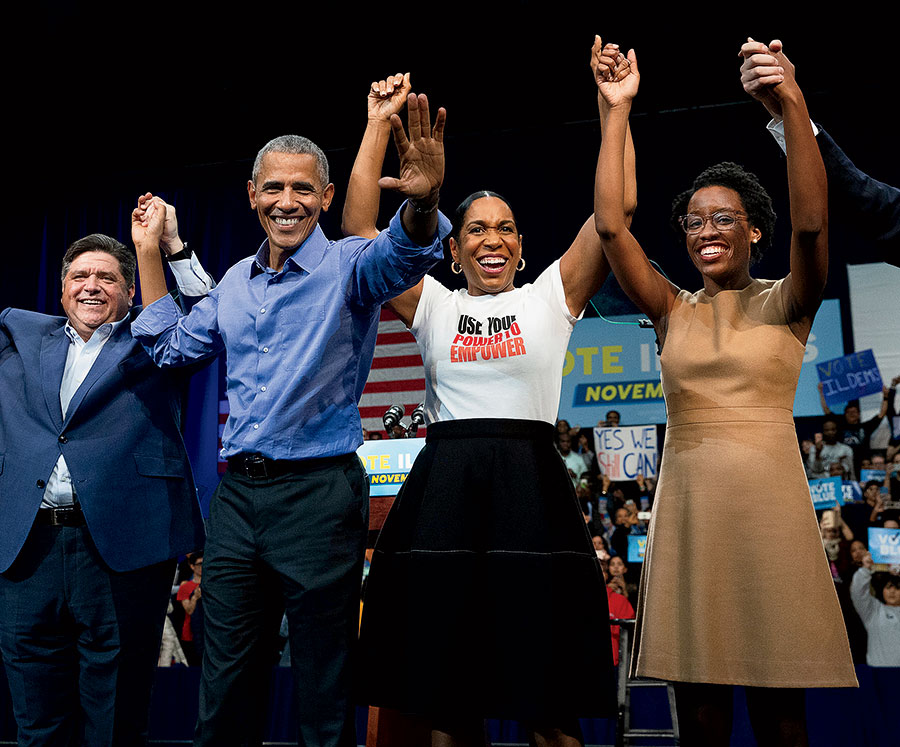
“People need help now,” Underwood said when I asked why she’d favored a middle road. “That’s what this legislation does.” In March, her proposal became law, as part of President Biden’s American Rescue Plan Act. Her success in pushing through her legislation reminded me of the old saying that there are no atheists in foxholes, the corollary being that there are no ideological purists in a national health crisis: People can espouse rigid beliefs on Facebook about America and freedom and antifa and the coming class war, but at the end of the day, what they care most about is being able to go to the doctor when they’re sick, being able to make rent, and buy food, and educate their kids.
Underwood seems to take umbrage at those who insist that a national government-run insurance system is a more direct path toward ending health care disparities than a complex system of subsidies and tiered plans. “I’m not an ideological person,” she told me. “And I think the way this debate is framed as single-payer versus ACA is really toxic.”
In Underwood’s view, there is a moral cost to delaying immediate remedies in the name of achieving more profound future gains. She recalled how during a community health rotation in nursing school, she’d go to her patients’ homes to make sure they were taking their medicine. For many of them, the problem was not that they couldn’t remember to take their pills, but that they couldn’t afford to buy them, having to rely instead on the free samples provided to doctors’ offices by pharmaceutical reps. “There were weeks when they couldn’t get enough samples from the pharmacy reps or health providers, and then there was a problem. I would spend time calling to see if a different practice had some extra samples or if the health department had gotten some. I’d advocate for the family. But not everyone has a nurse with a line to the department of health advocating for them.” Relying on free drugs was hardly a sustainable practice, but it helped those people in the moment.
“The framework that I always use is that there is a window of opportunity to make policy change,” Underwood said, “and when the window is open, you, as the advocate, need to be aggressive about making sure that your issue can move, because once folks move on and that window closes, it’ll be gone. And for me, we are in this moment where people understand health equity issues. They understand the need for people to have health care and that my responsibility as a policymaker is to make sure that we’re doing everything we can.”
I asked what she’d say to activists who believe that now is the time to push for more systemic change. She looked exhausted by the question, and was perhaps relieved when she realized we’d reached the end of the time her team had allotted for our first interview.
Later, researching the finer points of her bill, I realized that the new law was going to save me around $200 a month.
A friend of mine who teaches college in Chicago once told me jadedly that whenever a student mentions growing up in Naperville, it’s guaranteed that the next thing they’ll say is how much they love their hometown. Lauren Underwood is no exception. Though the congresswoman studiously avoided talking about her personal and family life over the course of a handful of interviews, she became animated when the subject turned to her growing-up years in Naperville, where she moved with her parents from Mayfield Heights, Ohio, a suburb of Cleveland, when she was 3.
At the time, Naperville — an affluent city on the DuPage River that’s now the fourth largest in Illinois and lies just outside the boundaries of the 14th District — was on its way to becoming a place very different from the one it had been. To give me a sense of this transformation, Underwood told me about a boy she had a crush on in the first grade: “His name was Brian Book, and I thought he was so cool because he lived on Book Road, and Book Road was named after his family because they owned this huge farm. But by the time I got to second grade, the Book family had sold their farm and moved to southern or central Illinois. And now there is no farmland, not even around Book Road.”
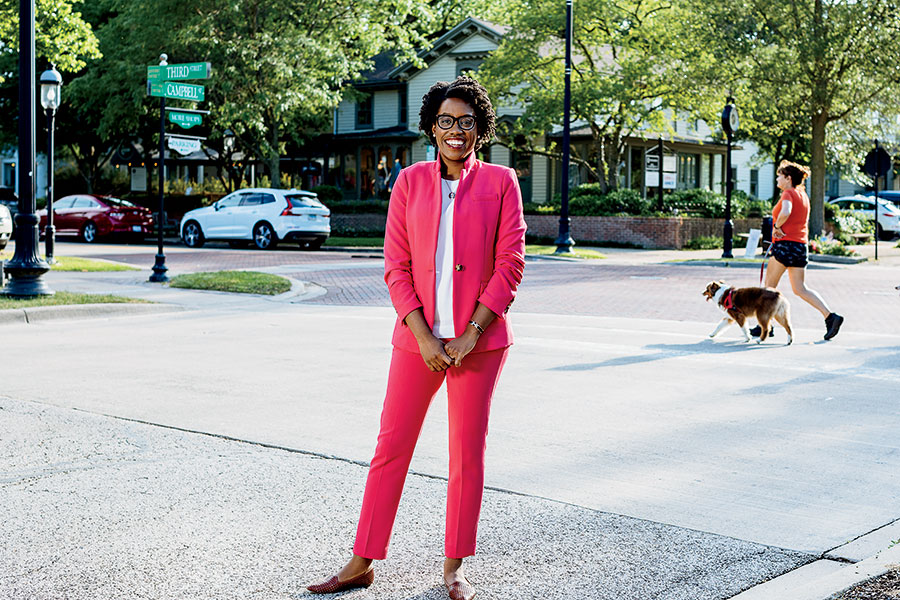
The bucolic landscape that once defined the town had already largely given way to subdivisions, strip malls, and what Underwood described as “all these new, nice things.” The schools were new, the parks were new, the houses were new, the libraries were new. This new Naperville seemed to have everything a middle-class family with high aspirations for their children might want or need.
The new Naperville, like the old one that had grown from a pioneer settlement, was a magnet for upper-income white professionals. Though Underwood readily acknowledged that “there weren’t a lot of other Black people there,” she never described the lack of diversity as an impediment, and pointed to Black classmates of hers who went on to high-profile careers, among them the WNBA star Candace Parker and Underwood’s sister, Lindsey, who works as a senior editor at the New York Times. “We had access to an upper-middle-class community at a time when the national economy was doing very well,” she said. “People invested in their kids.”
Underwood described her participation in a yearlong internship that Naperville’s mayor had created to give teenagers experience in local government. During her junior year at Neuqua Valley High School, she won an appointment on the town’s fair housing commission, which, at the time, was facing legal challenges over a local law that allowed renters to present Section 8 vouchers to landlords as a source of legal income. There weren’t a lot of rental properties in Naperville, and many landlords were refusing prospective tenants who were on public assistance. Underwood remembers her surprise at learning how hard it was for low-income renters to get a lease. “It introduced me to the concept of housing discrimination on a really local level.”
The experience ignited a passion for public policy, but as she neared graduation, she felt pressure to follow a track that guaranteed stability. “No matter where you live,” her parents had always told her, “you always need to be able to support yourself.” It was fortuitous, then, that when she entered nursing school at the University of Michigan, the curriculum was undergoing significant change. “In the past,” Underwood said, “schools of nursing were like, ‘We are Michigan nurses. You will learn to tuck bedsheets the Michigan nurse way. You will be the most competent Michigan nurse and you will only do the things we teach you.’ ” But by the time she began her education, there was far less emphasis on bedsheets and far more on policy and patient advocacy. “These folks were like, ‘No, we want you to be a leader, and we will give you the tools you need to be a leader,’ ” she said of the faculty at Michigan. “And that changed my whole life.”
Lauren Inouye, a nursing school classmate who has remained friends with Underwood and is now the chief program officer at the American Academy of Nursing in Washington, D.C., remembers encountering the future lawmaker on the first day of an 8 a.m. class in health policy. No one was excited to be there, she recalls, with the exception of the freshman from Naperville. “It was winter in Michigan, there was a foot of snow on the ground,” says Inouye. “We had to trudge all the way across campus, and by the time we got there, Lauren was always ready to go.”
Inouye says her friend was invariably energized. For one class assignment, Inouye and Underwood were paired to work on a presentation. “I just remember thinking, Thank God she’s my partner,” Inouye says. “The class focused on honing leadership skills for nurses. Most of us were just starting to think about our career paths — what specialty in nursing we wanted to go into. She already saw herself 10 or 20 years down the road. She always knew she would serve in public office.”
Nursing has not been an established path to political power like law or business, but Inouye sees that changing, with Underwood serving as a sort of advance guard. This called to mind the poll conducted by Gallup each year that ranks Americans’ estimation of various professions in terms of ethics and honesty. Nursing consistently ranks No. 1. (Car salespeople typically come in last, one notch below members of Congress.) It’s tempting to assume that this trust comes from the fact that nursing, unlike law or business or even medicine, is a field traditionally associated with nurturing as opposed to ambition. Underwood’s career seems to suggest that the two needn’t be mutually exclusive.
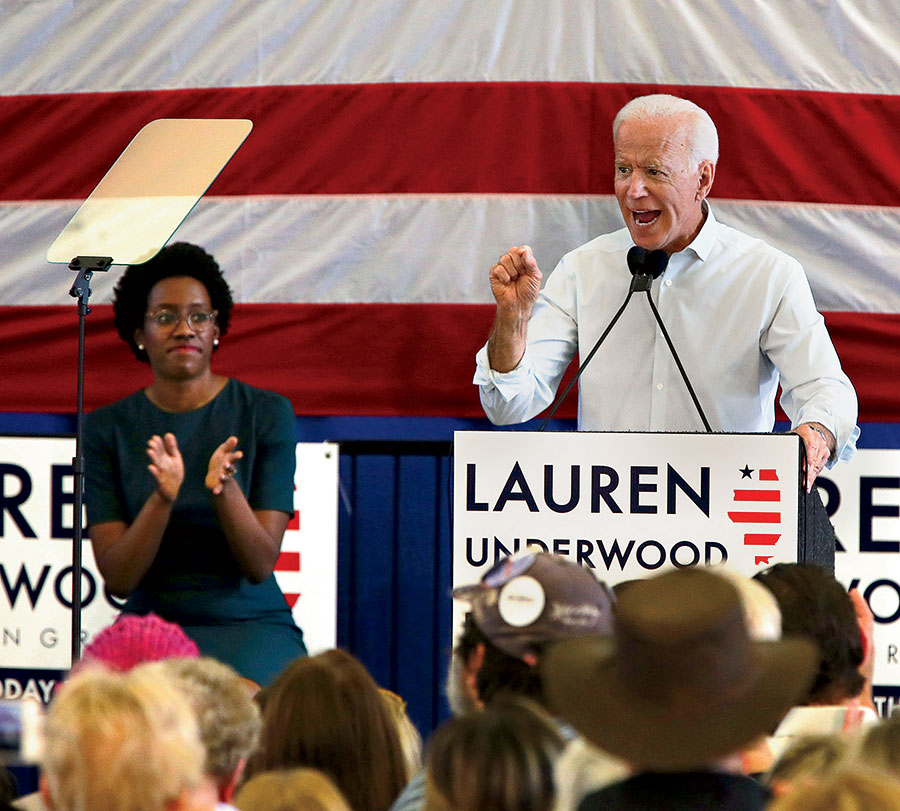
When Underwood was 8 years old, her heart began racing so fast during a swimming lesson that she was taken to the emergency room. She was diagnosed with a type of arrhythmia that can require close medical observation over a lifetime. In June 2018, about a year after announcing her surprise candidacy for the 14th District’s congressional seat, she alluded to that diagnosis in a tweet: “I live with a preexisting condition called supraventricular tachycardia. It makes my heart race — and it’s the reason why I’m in this race.”
I knew that health care reform had been the central plank of her political platform, but during one of our conversations I asked the congresswoman to go deeper on what prompted her, a political neophyte, to run for national office in a district that had sent only one Democrat to the House of Representatives in 80 years. By way of answering, she related an anecdote.
In the spring of 2017, she decided to attend a town hall meeting in St. Charles, a suburb in the 14th District, organized by the League of Women Voters for Randy Hultgren, who was hoping to coast to a fifth term as the area’s representative in Congress. Having finished her stint at HHS, Underwood had just moved back to Naperville, commuting to her new job as a regulatory strategist for a Medicaid managed-care company called NextLevel Health. In what would turn out to be his only open-to-the-public event of the campaign, the then-51-year-old congressman — a former aide to onetime House speaker Dennis Hastert, who’d previously held the seat and later admitted to child molestation, serving time for related financial crimes — stated his support for repealing Obamacare. But he vowed that any repeal would not strip away protections for people with preexisting medical conditions. And yet a little more than two weeks later, Hultgren voted for a version of the repeal legislation that would essentially do just that, by making coverage for such people extremely expensive.
Underwood — who was still grappling with the implications of her friend Shalon’s death and had spent the previous three years working to improve Obamacare — was aghast. “That’s when I decided to run for Congress,” she said. “I didn’t know that I would win, but I knew that I could win, and I knew that if I won, I wanted to try to fix this.”
In what the Chicago Tribune called a “stunning upset,” Underwood narrowly defeated Hultgren after besting a field of Democratic primary candidates consisting entirely of white men. She entered the House of Representatives with a freshman class that was historic for its proportion of first-time candidates and for the number of women, many of them young and progressive and many of them people of color.
More than a few political analysts attributed Underwood’s win in part to the redrawing of the 14th District’s boundaries in 2010, a move that eliminated much of the district’s rural western portion. Demographic shifts, as well as an endorsement from Biden, were also cited as reasons for Underwood’s razor-thin 2020 victory over Oberweis, who took a page from the Trump playbook by challenging the results in an acrimonious fight that dragged on until May, when the Committee on House Administration found that his claims of election fraud were not credible.
But Underwood believes a more fundamental political awakening is at play, one that allows a newcomer candidate like her to run on critical bread-and-butter issues and win. “My district believes that health care is a right,” she told me. “And I believe the majority of American people believe that.” Then, echoing something she’d said earlier, she added, “The problem is that the folks who hold the power have not reflected the values and the lived experience of the American people. There is a significant misalignment right now.”
Underwood seems confident that she’s got the power to correct that misalignment, even if she may not yet have achieved the kind of cult status that gets you known just by your initials. “Every power dynamic in Washington has basically shifted,” she said. “The loudest and boldest and most powerful voices coming out on Capitol Hill are the voices of women. And with the exception of our speaker, they are women of color. And when you think about power, who holds power, who sets the agenda, who dominates and drives conversations, it has rarely been women.”
The unuttered continuation of that thought might be: At least not the right women. Not the ones who take care of people when the chips are down, when the schools are closed, when someone’s sick, when someone’s hungry, when someone’s lost their way — obligations that have prevented so many women, including the nearly 3 million who dropped out of the workforce during the pandemic, from taking a seat at the table. I’d come to think of this circumstance as the Cinderella problem, because remember, it’s not that Cinderella isn’t invited to the ball, it’s just that before she can go, she has to finish all her chores. Equitable health care alone may not resolve that problem, but it might be enough to give some women — those who, as Shalon Irving did, push themselves to the limit to have both family and career — a chance to go to the dance.
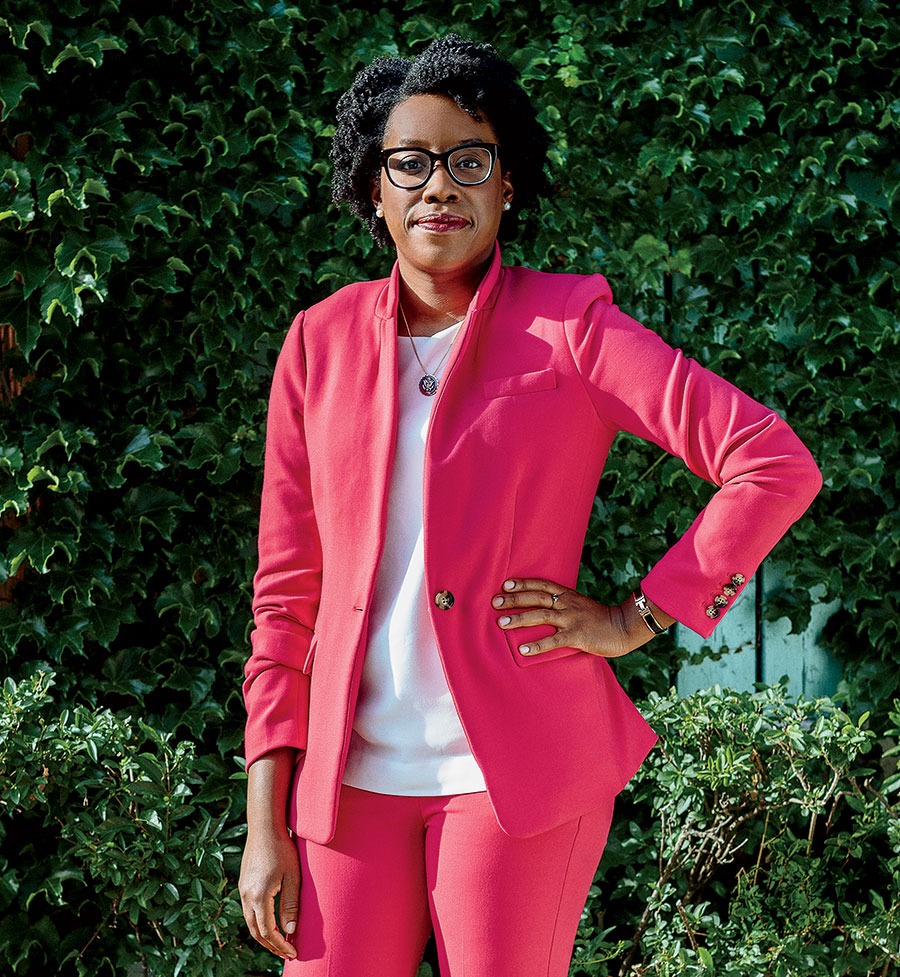
In March I attended a public appearance Underwood made in Woodstock, a city of 25,000 on the semirural fringe of the Chicago metropolitan area. To get there, I drove northwest on I-90, past O’Hare, past the subdivisions and office parks of Schaumburg and Hoffman Estates. Once off the interstate, I saw more than a few Trump signs in front of houses and storefronts, though the election had been certified two months earlier. The window of one gas station just outside of town was draped in a hand-painted sheet imploring passersby to Make America Great Again.
When I arrived, Underwood was taking her place before a lectern that had been set up in a park in the center of town. Flanked by a couple of City Council members and facing a small crowd of residents and a clutch of local reporters, the congresswoman spoke about how the Biden administration’s American Rescue Plan Act, and the provision for health care affordability she had worked to include in it, would provide relief to the city’s families.
When it came time for questions, a woman standing near me raised her hand. I’d noticed her earlier, listening impassively with her arms tightly crossed and her jaw set, her three children playing in the grass behind her. She said she had a friend who’d been trying to hire a home health aide for months. She was offering good money, $15 an hour. But how could her friend compete with Biden’s unemployment benefits? Why would anyone work when the government was paying them to stay home? What was Lauren Underwood going to do about this?
Underwood seems confident she’s got the power to make change happen, even if she’s not yet known just by her initials.
Underwood expressed sympathy for the woman’s friend and, without getting into specifics, offered assurances that the provisions of the new law would help such women get through the crisis —but would also get workers to a place where they could earn enough to support their own families and rebuild what had been lost. The woman listened, then essentially repeated her question-comment, looking angrier than before.
Later, during another Zoom call, I asked Underwood about the exchange. “The pandemic has affected everybody,” she said. “Everybody. And I know that that woman who came to our event was obviously going through something. She was experiencing some kind of pressure or anxiety. But, you know, I suspect that if we were in private and really engaged one another for longer, there would have been some other things going on there, that part of what she’s saying is, you know, ‘Who’s helping us?’ Somebody has a long-term health care challenge, her needs aren’t being met. … And so while her approach is different and her ideas about solutions are different, I don’t see there being this fundamental difference between us.”
I asked if the woman’s demeanor, which verged on openly hostile, had bothered her. “Here’s what I think. I think that woman knew that I would talk to her. She came to the event. She knew that she wouldn’t have to stand on the side and be ignored. She stood there and listened, and she was quiet. And I went to her first. And so to me, that was actually a positive interaction.”
Whatever the characterization of that tense Q&A, it says a lot about the challenges Underwood faces as she heads deeper into her second term — and about the thick skin she’s developed after her first. I remembered that when the woman in Woodstock had pressed on, seemingly oblivious to the answer she’d heard, Underwood had made one more attempt to explain her position. Finally, when that response seemed to fall on deaf ears yet again, the congresswoman nodded, looked out toward the rest of the crowd with a smile, and said, “Next question?”



